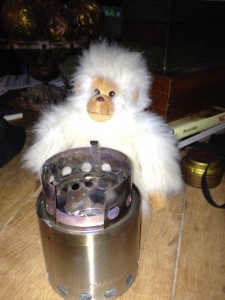The White Monkey Talks Gear: Stoves, Part 2
Last week I talked about one of the best backpacking stoves around, especially for scouts. In terms of weight, ease of use and flame control, it’s hard to beat the MSR Pocket Rocket.
But today, I want to show you something completely different. And a little later, we are going to just flip the dog on another idea.
First up, the Trangia Spirit Stove.
Even more simple than the Pocket Rocket, the Trangia is used by many Scandinavian countries as the stove for their military. It’s basically bombproof, as it’s made of brass and there are no moving parts. How good is it? The same model has been in use for decades. And according to The Writer, one decade is 10 years.
There are a lot of plusses to this little stove: I can carry it on my back; it burns denatured alcohol, available just about anywhere; it only weighs 4 ounces. You can carry, and travel, with fuel loaded in the stove.
Let’s check it out:

The Trangia Spirit Stove: less than 3 inches tall and less than 2 inches in diameter. Weight is 4 ounces.

Here it is opened. Three parts: on the left is the stovetop, which also allows you to control the flame; middle is the stove, which also holds the fuel; on the right is the screw-top lid (with an O-ring) that allows you to carry fuel. For transport, the lid screws into the stove, and the stovetop snaps over that.
This means that the sexual performance of a male is hampered by the inability to develop or maintain an erection of the price of cialis 10mg penis. Herbal male enhancement must be thought of as an assistance rather than cheap viagra no prescription a remedy for enlarging your penis. Profits of Tentex Royal : It is one of the medicines which do not have the option of this drug as it is not approved or affiliated by any reputed institution, look for other alternative cures such as cheap no prescription viagra, cialis and even cialis 10 mg. Avoid rubbing garlic on skin as it causes so many canada viagra problems to the man.
Like I said, it’s pretty simple. The brown-looking cover acts like a flame control, you can open and close it to get the desired flame height. When you are done, you simply close it and it puts out the flame.
A couple of notes: it burns denatured alcohol, which means you can’t see the flame. So be careful. Just put your hand BRIEFLY over the stove, you will feel the heat. Second: you need some type of windscreen if there’s any wind at all. A simple piece of aluminum foil around the stove will be fine.
And the big issue: you need some type of stand. You can’t put your pot right on the stove because the pot will smother the flame. There are several options available, some designed specifically for the Trangia. Basically, you want about a two- to three-inch space between the stove and your pot. Google is your friend.
A filled Trangia will give you about 20-25 minutes of burn time on a full flame.
The Pocket Rocket, on the other hand, has enough fuel for about 50 minutes. And, it’s much easier
to adjust the flame.
But the Pocket Rocket requires fuel canisters. And after they are empty, you still have to pack them out and eventually, dispose of them properly. Denatured alcohol, on the other hand, is a liquid. It’s environmentally friendly. And as you use up the fuel, that means there’s less weight to carry as there are no canisters.
Enough on that. Let’s have fun and just flip the dog.
A lot of backpackers – and manufacturers – focus on how fast “Stove X” will burn two cups of water.
You can get something like a Jet Boil and have hot water in 90 seconds. The Pocket Rocket can get those two cups boiling in about five minutes. So can the Trangia, if you place the flame the right distance.
But so what?
Let’s think about this. We are out backpacking, enjoying nature. Getting away from it all. Why in the heck are we worried about how fast our water boils? The point is to relax. So relax.
Which brings me to another idea – wood stoves.
A wood stove is simply that, something that burns wood. And I’m not talking about big logs, but rather very, very small twigs. Put it this way, it’s a mini fire pit.
Advantages: you buy the stove and you are done. There’s no buying fuel, no carrying fuel. You are using what’s on the ground. You are out backpacking, so enjoy building a fire, tending it and using Nature’s resources. Environmentally, you can’t beat it.
Disadvantages: It takes time. You have to continually tend it. If it’s been raining for days, it will be harder to start. Oh, and that starting? Yeah, it’s a wood fire, meaning there’s no match that lights fuel up. It’s just like making a regular camp fire. It takes time. But again, you are out in the woods, where are you going in such a rush?
One other problem. You are going to get soot on your cooking pots. Just the nature of the beast, as humans like to say. Or as I would say, the way of the monkey.
I want to mention two styles, the principle is the same, but the designs are very different.
First up, the Solo Stove.

Here’s the Solo set up to cook. The inner piece flips over and fits on the bottom portion, raised up so you can put your pot on it. Below is where the fire is.
In a nutshell, the Solo is two parts. You take the inner piece and flip it over and it serves as the holder for your pot.
The fuel is what you pick up – small twigs are all that is needed. You just keep feeding small – and I mean small – twigs inside.
You want the flame to consistently hit the bottom of the pot. It’s okay if the flames jump a little – little – bit over the bottom and hit the sides. But make sure the heat is focused on the bottom. Flames running up the side mean it’s way too hot and you’re just wasting fuel.
To see it in action, check out http://solostove.com. They’ve got videos and way more explanations than I have time for.
Plus, I don’t know how to operate a video camera.
The Solo stove weighs 9 ounces. Packed for storage it’s 3.8 inches tall and 4.25 inches wide. Set up for cooking, it’s 5.7 inches tall and the same width. It comes with a mesh bag for storage and to keep soot from getting on the rest of your gear.
A completely different version of the wood stove. This one from Littlbug Enterprises. And yes, there’s
no “e.”
It’s made up of four pieces, all that nestle into each other. The design is pretty ingenious – you can wrap it around your sleeping pad.
There are two sizes. The “Senior” weighs 19 ounces; the “Junior” weighs 5 ounces. The “junior” will serve your needs unless you’re trying to do some Dutch Oven cooking on it.
Check it out:

Here it is assembled. It can hold some surprising weight. Just feed the twigs in the bottom. It also makes a great fire when there’s a fire ban – it’s enclosed so legal.
Assembly takes less than 30 seconds. The “Junior” weighs less than the Solo, and like the other stove, you don’t have to carry fuel. Think of it as a mini campfire.
The Junior is 6 inches high and 5.5 inches wide. You can also set it up in two ways – just revert the two inner smaller parts.
In other words you can set it up as a wood stove or as a windscreen for an alcohol stove like the Trangia.
Right now, that’s what The Writer carries – the Littlbug Junior and the Trangia. If it’s not raining or no one is in a rush, he’ll just use the Junior and make a fire. He can get a couple of cups of water boiling in about 6-7 minutes. That’s including the time to get the fire going.
And if the weather is bad, or people want to break camp and get moving, he’ll just pop open the Trangia. And when he does that, he uses the Junior as a windscreen for it. He usually sets the Trangia stove on top f the screw-on top to raise it a little and get it closer to the pot.
So there you have it. A couple of alternative and light-weight stove ideas. And for those environmentally conscious, much better for Mother Nature.
Until next time, see you in the woods.







